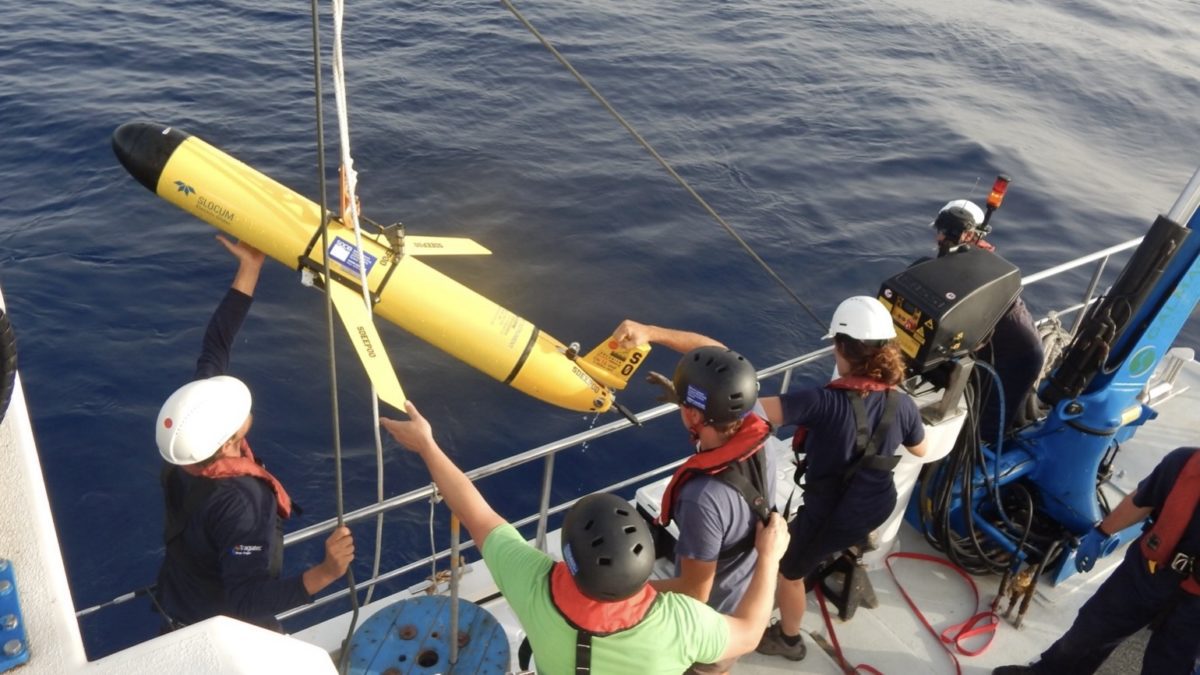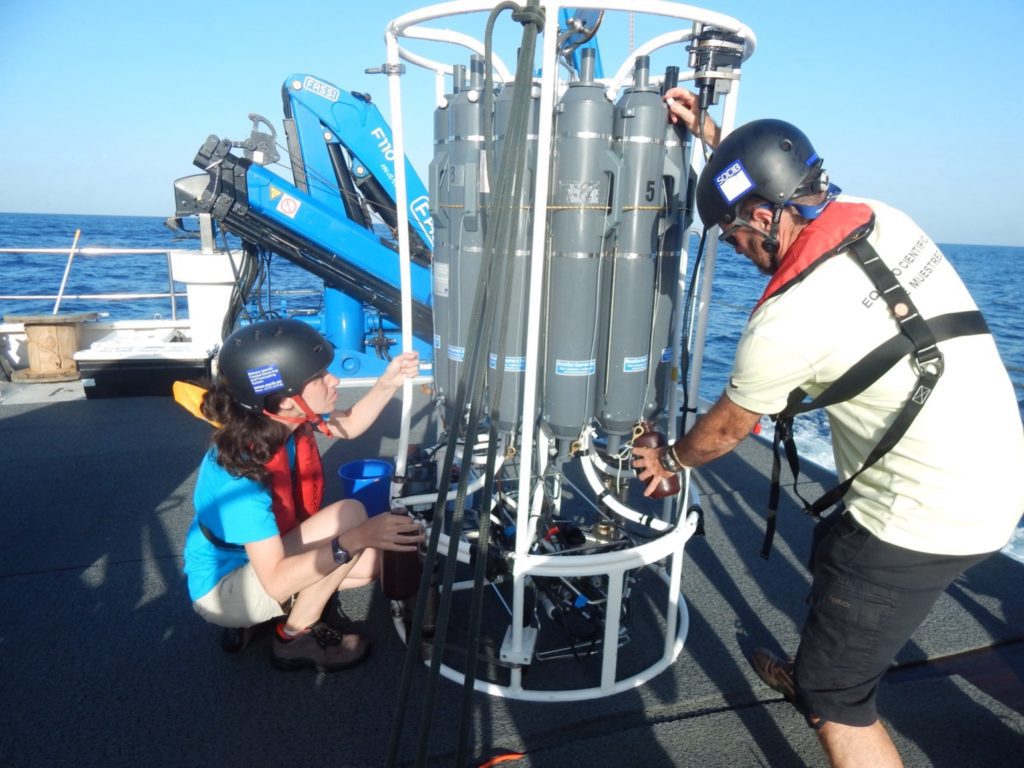For microscopic organisms, ocean currents act as ‘expressway’ to deeper depths, study finds
 An autonomous underwater glider is deployed from the research vessel SOCIB by Spanish collaborators. The glider collects measurements of salinity, temperature, oxygen, and chlorophyll, while repeatedly moving up and down through the ocean over several hundred meters and traversing laterally as directed. Such measurements help to detect underwater features such as those described in the article.
(Photo Credit: Amala Mahadevan, ©Woods Hole Oceanographic Institution)
An autonomous underwater glider is deployed from the research vessel SOCIB by Spanish collaborators. The glider collects measurements of salinity, temperature, oxygen, and chlorophyll, while repeatedly moving up and down through the ocean over several hundred meters and traversing laterally as directed. Such measurements help to detect underwater features such as those described in the article.
(Photo Credit: Amala Mahadevan, ©Woods Hole Oceanographic Institution) May 2, 2024
New research shows how tiny plant-like organisms hitch a ride on ocean currents to reach darker and deeper depths, where they impact carbon cycling and microbial dynamics in the subtropical oceans.
Woods Hole, Mass. -- Some of the ocean’s tiniest organisms get swept into underwater currents that act as a conduit that shuttles them from the sunny surface to deeper, darker depths where they play an important role in affecting the ocean’s chemistry and ecosystem, according to new research.
Published in the Proceedings of the National Academy of Sciences and based on fieldwork during three research cruises spanning 2017 to 2019 as part of the ONR DRI `CALYPSO (Coherent Lagrangian Pathways from the Surface Ocean to Interior), the study focuses on subtropical regions in the Mediterranean Sea. It uncovered how some microscopic single-celled organisms that are too light to sink beyond 100 meters or so — like phytoplankton and bacteria — end up going deeper into the ocean where there's not enough sunlight for these photosynthetic organisms to grow, live and eat.
“We found that because these organisms are so small, they can be swept up by ocean currents that then bring them deeper than where they typically grow,” said Mara Freilich, former MIT-WHOI Joint Program student, currently an assistant professor at Brown University, who conducted the research during her Ph.D. with Amala Mahadevan, Senior Scientist at WHOI in a close collaboration with Alexandra Z. Worden, Senior Scientist at the Marine Biological Laboratory and her team. “It's often a one-way trip for these organisms, but by taking this trip, they play a critical role in connecting different parts of the ocean,” Frelich said.
The currents are called intrusions and by sweeping up the tiny organisms, they help change the types of food available in the deeper layers of the ocean while also transporting a significant amount of carbon from the water surface. This helps feed other organisms in the ocean’s food chain and increases the complexity of the ecosystem at deeper depths, influencing how life and chemistry work underwater.

Lead author, Mara Freilich, along with scientist, Simon Ruiz, collecting water from Niskin bottles that were used to sample different depths of the ocean beneath the research vessel, SOCIB, during the first expedition from Mallorca when Freilich was a graduate student at Woods Hole/MIT.
(Photo Credit: Amala Mahadevan ©Woods Hole Oceanographic Institution)
Altogether, the study challenges conventional understanding of how carbon, which is turned into organic matter by photosynthesis in the sunlit layer of the ocean, gets transported to depth.
“The majority of photosynthesis — by which light is converted into organic carbon, a food source for living organisms — happens in the upper 50 meters of the ocean, so the question has always been: How does the carbon that gets fixed through photosynthesis get into the deep ocean?” Freilich said. “The sinking of carbon-rich particles has always been thought to be the only answer to this question. But what we found is that tiny, single-celled organisms get caught in the oceanic flow to form intrusions. Such intrusions are significant features of the subtropical ocean — while they extend tens of kilometers laterally, they also descend hundreds of meters in the vertical, bringing cells and carbon with them. This mechanism has been unaccounted in previous estimates of carbon transport.”
The researchers found the intrusions occur year-round and originate in areas rich with biomass, including where the plant-like organisms are at their highest concentrations. Previously, ocean currents were only thought to carry carbon to depth seasonally. The researchers suggest these intrusions are widespread in the world’s subtropical oceans. They provide conduits for the continual transport of carbon and oxygen from the sunlit ocean to depth.
“We observed microbial communities that looked just like surface microbial communities down to 200 meters,” Freilich said. “In other regions, we think this could be a lot deeper. To our surprise we found that the majority of microbes in the intrusions were bacteria that feed on carbon fixed by the photosynthesizing cells. This showed that the bulk of the biomass transported from the sunlit layers comprised of non-photosynthetic microbes.”
In partnership with Spanish researchers at IMEDEA and SOCIB in Mallorca, and Italian scientists from ISMAR and CMRE, the scientists went on three trips to the subtropical Mediterranean ocean for the study. They used special tools to measure properties like water temperature, salinity, and the abundance of the tiny organisms at different depths. Genetic diversity analyses alongside advanced methods for enumerating and distinguishing microbial populations were then performed and helped show the differences between intrusion samples and background waters. Seeing that the microbial communities in the deeper intrusion samples resembled surface microbial communities demonstrated that they were being transported to depth, and transported fast enough that these surface communities were still largely intact, not degraded. The researchers also used computer models to simulate ocean currents to reveal how the communities of tiny algae and bacteria moved in the water. Worden highlights that “with the strong data from the Mediterranean establishing this process of 3-dimentional conduits as a mechanism for bringing surface microbes to the dark ocean in warm waters, we have been able to see traces of similar export in major open ocean regions such as the subtropical North Atlantic at the Bermuda Atlantic Time-series Study (BATS) – expanding the implications of the CALYPSO-based sampling.”
Along with underscoring the ecological importance of intrusions in shaping oceanic biodiversity, the study also touches on how intrusions could be affected by climate change. It is thought that as the Earth's oceans get warmer, the proportion of carbon in tiny cells would increase and the transport in intrusions may not be as affected as other mechanisms that carry carbon to depth. Intrusions change our understanding of how carbon moves around in the ocean and could help regulate carbon storage and microbial dynamics in the deep ocean.
“There's so much more to explore now that we've found this,” Freilich said. “What's next is taking what we've learned here and determining if we can use this to predict how changes in the microbial community composition would affect the transport of carbon and the global carbon cycle in a changing climate.”
###
About Woods Hole Oceanographic Institution
The Woods Hole Oceanographic Institution (WHOI) is a private, non-profit organization on Cape Cod, Massachusetts, dedicated to marine research, engineering, and higher education. Established in 1930, its primary mission is to understand the ocean and its interaction with the Earth as a whole, and to communicate an understanding of the ocean’s role in the changing global environment. WHOI’s pioneering discoveries stem from an ideal combination of science and engineering—one that has made it one of the most trusted and technically advanced leaders in basic and applied ocean research and exploration anywhere. WHOI is known for its multidisciplinary approach, superior ship operations, and unparalleled deep-sea robotics capabilities. We play a leading role in ocean observation and operate the most extensive suite of data-gathering platforms in the world. Top scientists, engineers, and students collaborate on more than 800 concurrent projects worldwide—both above and below the waves—pushing the boundaries of knowledge and possibility. For more information, please visit www.whoi.edu
